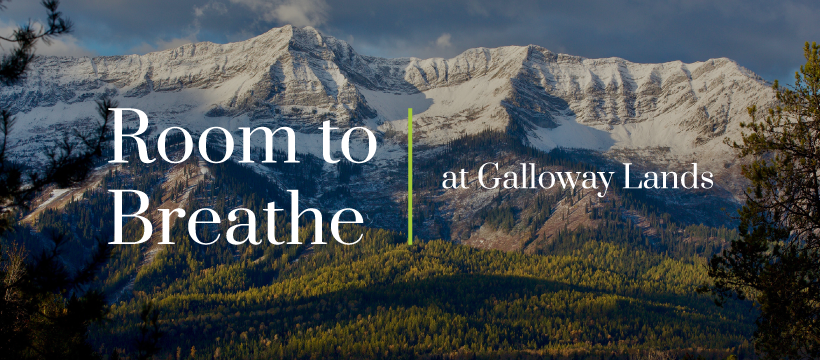By Richard Haworth, Haworth Development Consulting Ltd., Land Use Planning Consultant for the Galloway Lands project.
There’s been a lot of talk lately about the proposed Galloway Lands development.
We understand that development and change in a community can be a complex, charged topic. We’d like to take this opportunity to provide more information to those who have questions, and set the record straight on misinformation that is circulating about plans for Galloway Lands.
MYTH: The Galloway development is currently fast tracking through the approval process without appropriate impact studies.
FACT: Neither the application process nor RDEK approval process for this project have been ‘fast tracked’.
The Galloway Lands proposal was commenced by the proponent in February 2021. The proponent has undertaken a thorough and complete assessment of the lands as part of the application process and has held their own public open house (over two days) and consultation with neighbouring interest groups. The proponent submitted the land use application to the RDEK on December 1, 2022.
Similarly, we believe that the RDEK has not fast-tracked any part of this approval. To the contrary, we believe that the RDEK has provided additional time for review beyond its normal protocols. The RDEK extended the referral period from 30 days to 60 days to allow time for meaningful consultation and the RDEK is also providing two days for the public hearing.
This clearly demonstrates that both the applicant and the RDEK have taken extra steps to ensure fulsome public involvement to obtain meaningful public input.
MYTH: The development proposal will eliminate a significant portion of the summer and winter use trails.
FACT: The current landowner permits use of existing logging roads for Nordic skiing in winter months only. No summer use of the lands is currently permitted. All summer use of the lands is trespass and is not permitted by the current landowner. The Galloway Lands proposal will permit public access to over 50% of the lands and most of the existing trails (summer and winter) in perpetuity.
MYTH: Water and sewer capacity should be confirmed before zoning proceeds.
FACT: Fernie Alpine Resort Utility Company (FARUC) has confirmed that suitable water and sewer capacity exist for this development. Like all other utilities in BC, the utility must demonstrate to regulatory agencies that suitable capacity exists prior to expansion of the utility.
MYTH: An update to the Elk Valley OCP should be completed before this project proceeds.
FACT: The Elk Valley OCP represents a clear vision for the Elk Valley that was adopted based on significant community input and balances the many voices heard during the OCP process. The Elk Valley OCP was prepared based on significant community input including newsletters and questionnaires sent to area residents, community meetings, visioning workshops where area residents helped identify a vision for future development, a public open house, and the draft OCP was presented to each of the Elk Valley municipal councils and staff.
The Elk Valley OCP was adopted by the RDEK in 2014. Of the 15 Official Community Plans in the RDEK, seven are older than the Elk Valley OCP and 11 are more than five years old. We believe that the Elk Valley OCP continues to represent the views of the majority of Elk Valley residents.
MYTH: The RDEK should be focusing on worker housing, not housing for the rich.
FACT: The Galloway Lands will be a higher-end development. However, we envision a significant portion of owners being full-time residents that will contribute to the economic and social wellbeing of the community.
Social housing and attainable worker housing is best suited to municipal centers proximate to services and transit. There are numerous opportunities for the development of social housing and attainable worker housing within Fernie while not excluding other forms of development.
The Galloway development would also add considerably to the tax roll for the RDEK making additional tax revenue available to fund social housing and attainable worker housing projects in the region.
Simply put, the value of the house is not a valid way to view housing supply. Building any house will increase supply thereby producing opportunities for solutions up and down the supply chain. Each type of housing has its’ appropriate location and market position.
MYTH: Transportation Impact Assessment should be completed before zoning proceeds. What is cost of intersection improvements?
FACT: The completion of a Transportation Impact Assessment (TIA) is a requirement of subdivision approval from MOTI (at MOTI’s sole discretion). The applicant will complete a TIA as part of the subdivision approval in accordance with the terms of reference established by MOTI.
Prior to submission of the zoning application, the proponent’s traffic engineers completed an assessment of the traffic generated and the required intersection design to confirm that it will meet at MOTI requirements.
The cost of all intersection improvements will be borne solely by the developer at no cost to the public.
MYTH: Environmental concerns raised by Wildsight and ERA should be addressed.
FACT: The Cascade Environmental Resource Group (CERG) report addressed the concerns raised by these groups. The fact that those groups did not like the findings does not make them invalid.
Since the RDEK granted 1st and 2nd reading of the zoning bylaw, the applicant has had CERG prepare an addendum to their original report (see attached). This report clearly states that the issues associated with the environmental health of the property are capable of being safely managed both now and into the future. This does not mean that the site will be damaged then rehabilitated. It means that damage will not occur in the first place.
The applicant has attempted to engage with both Wildsight and the Elk River Alliance since this project commenced in 2021. The Elk River Alliance specifically chose to not engage but rather to comment through the public process. Wildsight has also declined to engage.
MYTH: Cascade Environmental Resource Group should be consulting with local environmental groups.
FACT: The reports prepared by Cascade Environmental Resource Group (CERG) were completed according to accepted professional standards and guidelines and are based on documented scientific findings. The CERG reports do not utilize information from special interest groups that cannot be supported in documented research.
We reviewed several environmental, floodplain and geotechnical reports prepared for the RDEK by other consultants and found no instances where those reports included any consultation with local special interest groups.
Regardless of whether CERG met with these special interest groups, CERG were aware of their well documented concerns and they are fully addressed in the final reports.
MYTH: Elk Valley Cumulative Effects (EV-CEMF) report must be considered and addressed in CERG report.
FACT: The Elk Valley Cumulative Effects Management Framework (EV-CEMF) was reviewed by Cascade Environmental Resource Group as part of the assessment of the Galloway Lands proposal. CERG’s findings are contained in the attached addendum from Cascade Environmental Resource Group which deals with this specifically.
MYTH: Mitigation is an indication that damage has been done and then it is too late.
FACT: The Cascade Environmental Resource Group addendum (attached) clarifies that its intention in the use of the word ‘mitigation’ is preventive, not a reaction to damage which has occurred. Mitigation prevents damage from occurring.
MYTH: A Conservation group needs to buy property from landowner.
FACT: The land use application being considered by the RDEK will permit limited residential development while permitting public recreational use of over 50% of the lands in perpetuity. This is a superior outcome for the lands given their long history as timber holdings. Refusal of the current zoning application will NOT result in the lands being available for purchase by a conservation group.
QUESTION: How does the proposal meet with the requirements of the Fernie OCP?
FACT: The lands lie within the bounds of the RDEK Elk Valley Official Community Plan and are designated for ‘Resort Expansion’. The land use proposed is consistent with the Elk Valley OCP. The lands are not within the City of Fernie or within the bounds of the current City of Fernie OCP. Development of the lands as proposed would not preclude a boundary expansion in the future.
QUESTION: How will the promises being made by applicant be enforced?
FACT: The proponent has agreed to enter into a Development Agreement with the RDEK. The terms of the Development Agreement have been established by RDEK staff and the applicant. The RDEK will not permit subdivision of the lands if the terms of the Development Agreement are not met in full.
QUESTION: How have you engaged the public with your plans?
FACT: The applicant commenced outreach to special interest groups and the public in April 2021. Since that time the applicant has had engagement or attempted engagement with Ministry of Transportation and Infrastructure, BC Parks, City of Fernie, Interior Health Authority, Ktunaxa Nation Council, Yaq̓it ʔa·knuqⱡi ‘it (Tobacco Plains Band), Fernie Alpine Resort, Snow Valley Community Association, Fernie Nordic Society, Fernie Trail Alliance, Elk River Alliance, and Wildsight.
The applicant held public Open Houses for the project on March 30, 2023 and April 1, 2023 which attracted 116 people.
Read about the commitment to preserving the beauty and integrity of the Galloway Lands and the long-term master plan that will protect the environment and set this neighbourhood apart.

